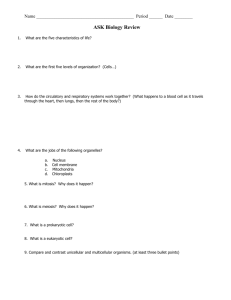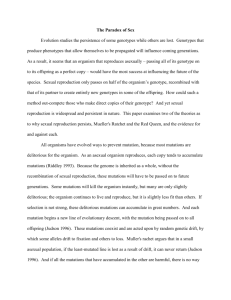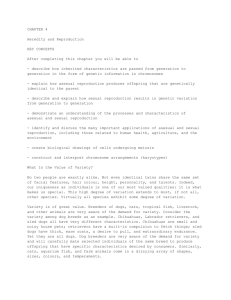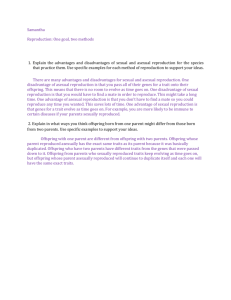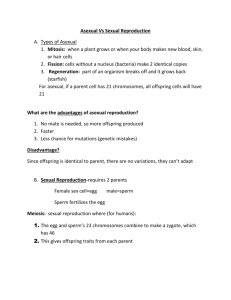The Paradox of Sex Evolution studies the persistence of some
advertisement
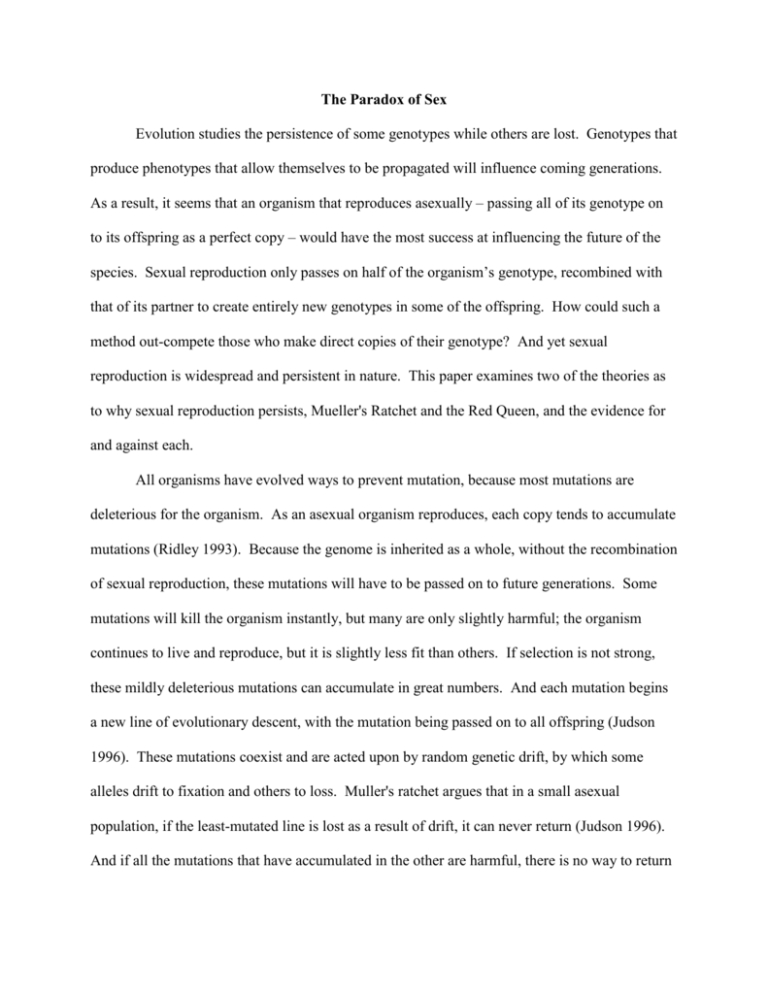
The Paradox of Sex Evolution studies the persistence of some genotypes while others are lost. Genotypes that produce phenotypes that allow themselves to be propagated will influence coming generations. As a result, it seems that an organism that reproduces asexually – passing all of its genotype on to its offspring as a perfect copy – would have the most success at influencing the future of the species. Sexual reproduction only passes on half of the organism’s genotype, recombined with that of its partner to create entirely new genotypes in some of the offspring. How could such a method out-compete those who make direct copies of their genotype? And yet sexual reproduction is widespread and persistent in nature. This paper examines two of the theories as to why sexual reproduction persists, Mueller's Ratchet and the Red Queen, and the evidence for and against each. All organisms have evolved ways to prevent mutation, because most mutations are deleterious for the organism. As an asexual organism reproduces, each copy tends to accumulate mutations (Ridley 1993). Because the genome is inherited as a whole, without the recombination of sexual reproduction, these mutations will have to be passed on to future generations. Some mutations will kill the organism instantly, but many are only slightly harmful; the organism continues to live and reproduce, but it is slightly less fit than others. If selection is not strong, these mildly deleterious mutations can accumulate in great numbers. And each mutation begins a new line of evolutionary descent, with the mutation being passed on to all offspring (Judson 1996). These mutations coexist and are acted upon by random genetic drift, by which some alleles drift to fixation and others to loss. Muller's ratchet argues that in a small asexual population, if the least-mutated line is lost as a result of drift, it can never return (Judson 1996). And if all the mutations that have accumulated in the other are harmful, there is no way to return to the original form without a rare case of backward mutation (Ridley 1993). Without recombination, offspring cannot have less mutations than their parents. As a result, organisms evolved sex, in which offspring have a range of mutations based on the genes inherited from two parents. Those with many mutations die, while those with few survive to reproduce; in the end, sex can decrease the number of mutations (Ridley 1993). Many people argue that Muller's ratchet has too narrow a scope to explain the evolution of sexual reproduction. There must be an average of at least one harmful mutation for every individual each generation for Muller's ratchet to be an effective reason for sex; if there are less mutations, it would be more effective to improve proof-reading rather than use sex to purge them (Ridley 1993). Both a large population size and a low mutation rate can slow down the ratchet and prevent the unmutated form from drifting to extinction (Judson 1996). In large populations, alleles are lost very slowly, so there is a good chance that the unmutated line would survive. Low mutation rates mean that the offspring would not accumulate harmful mutations and thus that the unmutated form would continue. Also, the force of selection can prevent the loss of the unmutated form if it is more fit than the mutated offspring, or can cause the evolution of an allelic change that results in the same phenotype, by a different set of mutations in the genome (Judson 1996). If a phenotype is the result of a complex interaction of many genes, there is a higher chance that if a mutation in one gene changes it, a mutation in a different gene might regain the original phenotype. Even though sex can help reduce the number of mutations, this alone does not seem like enough of a cause to explain the overwhelming tendency of organisms to evolve sexual reproduction. There are probably other factors involved in the prevalence of sexual reproduction. Another explanation is known as the Red Queen hypothesis, which states simply that sexual reproduction is selected for to prevent disease (Ridley 1993). Disease-causing agents bind to proteins in the cell membrane in order to gain access to the cell, which is destroyed as the disease reproduces. As a result, diseases evolve to be most effective at binding the most common proteins in their environment. Organisms that have many different kinds of cell proteins have a better chance of avoiding disease (Ridley 1993). Sexual reproduction preserves heterozygotes in the community, which have two different alleles for the same gene, allowing more variation in that individual. The offspring of sexually reproducing individuals inherit a variety of genotypes as a result of recombination; thus there is a better chance that at least some of the offspring will avoid disease and survive to adulthood. Asexual clones have the same genotype, and all of the offspring of an asexually reproducing organism can be wiped out by one disease (Ridley 1993). The pressures of the Red Queen hypothesis could also be circumvented by other factors. Many ancient asexual lineages exist in environmental situations that minimize disease, like plants in arctic areas or organisms that are widely dispersed so that diseases cannot easily travel from one to another (Judson 1996). Other common asexuals are microscopic organisms that produce many offspring at once and are not often subject to disease (Ridley 1993). Thus these organisms do not need sex to ward off disease. The two theories are based on different models of evolutionary change. Muller's ratchet assumes that genetic drift has the greatest effect on evolution, while the Red Queen hypothesis argues that selection is the more powerful force. In most populations, of course, both factors are involved, and both theories may affect the persistence of sexual reproduction. Many scientists have tried to identify which mechanism is at work today on populations that can reproduce either sexually or asexually. Lively (1992) examined the breeding habits of freshwater snails to look for evidence of two hypotheses: the Red Queen hypothesis and the idea that asexual reproduction occurs when there is a high cost involved in finding a mate. In particular, Lively wondered if the correlation others had found between low parasitism and low sexual reproduction might have been due to the fact that there is less parasitism in areas where there is low population density, which is also where an organism has difficulty finding a mate. The snail density was estimated for a subset of the lakes in order to test the idea that small populations are correlated with asexual reproduction, and also the idea that small populations are correlated with low parasitism. No correlation was found between low population size and asexual reproduction rates, even allowing for the different effects of disease in different population sizes. But there was a correlation between asexual reproduction in areas with low rates of disease. Lively recognizes that these results do not give conclusive evidence that the Red Queen hypothesis is at work in these populations, but he considers it the most likely explanation. When disease is common, organisms reproduce sexually so that the most possible offspring survive the disease (Ridley 1993), and this correlation is seen in freshwater snails. In populations like snails, where both modes of reproduction exist, the persistence of both methods depends on a number of competing factors. As Lively (1992) showed, snails reproduce sexually when disease is present but asexually when it is not. In the short term, as disease is a variable factor, both modes will persist. However, if disease were to become a constant pressure, in the long term sexual reproduction would out-compete asexual reproduction, and the snails might lose the ability to reproduce asexually. On the other hand, if disease were to cease to be a problem entirely, the asexual line would out-compete the sexual if Muller's ratchet or some other method did not halt it (Ridley 1993). The balance of selection and the problems caused by genetic drift in asexual populations keep both modes present until something changes. Sexual reproduction is widespread in the natural world, and is obviously the result of many evolutionary pressures. Because it is so widespread and persistent, it seems likely that it is not all due to one influence. Evolution is affected by selection, drift, mutation, and other factors. Sexual reproduction is due to the effects of all these factors and organisms' responses to them. It cannot be explained by a single, universal factor, but by an understanding of the many factors that are involved.



